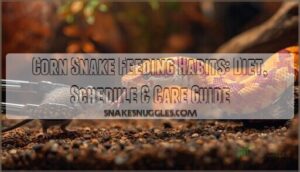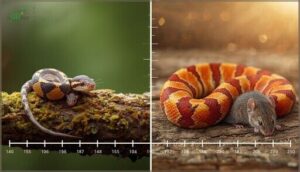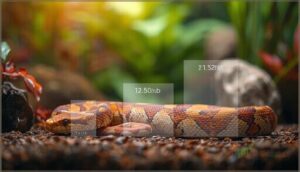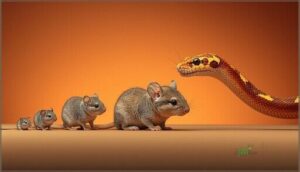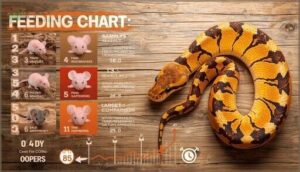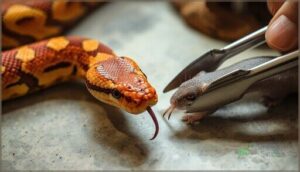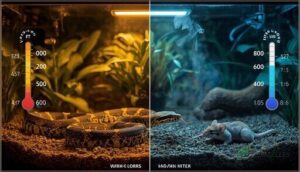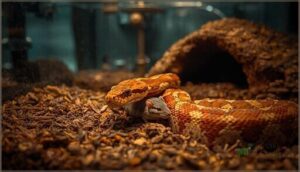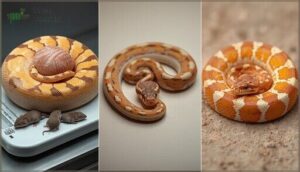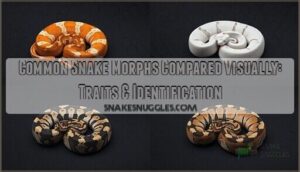This site is supported by our readers. We may earn a commission, at no cost to you, if you purchase through links.
Your new corn snake coils around your arm, tongue flicking rapidly, and you wonder: what exactly should I be feeding this thing? While pet stores might hand you a simple “feed it mice” answer, corn snake feeding habits are far more nuanced than tossing rodents into a tank.
These opportunistic hunters have evolved specific dietary needs shaped by seasonal prey availability, environmental cues, and metabolic demands that don’t simply disappear in captivity. Getting the feeding equation wrong—whether it’s prey size, frequency, or presentation method—can trigger regurgitation, refusal to eat, or long-term health complications like metabolic bone disease.
Understanding how these colubrids hunt, digest, and thrive nutritionally transforms feeding time from guesswork into a precise science that keeps your snake healthy for its 15-20 year lifespan.
Table Of Contents
- Key Takeaways
- What Do Corn Snakes Eat in Nature?
- Corn Snake Diets in Captivity
- Nutritional Needs of Corn Snakes
- Feeding Frequency by Age and Size
- Choosing and Sizing Prey Items
- Feeding Techniques and Best Practices
- Environmental Factors Affecting Feeding
- Common Feeding Challenges
- Health Risks of Overfeeding and Underfeeding
- Ethical and Responsible Feeding Practices
- Frequently Asked Questions (FAQs)
- Can corn snakes fast during breeding or shedding?
- How does stress affect a corn snake’s appetite?
- What signs indicate a corn snake is ready to eat?
- How do you encourage a picky corn snake to eat?
- Can corn snakes eat eggs or chicks?
- Do corn snakes need calcium powder supplements?
- How long can corn snakes fast safely?
- Should I feed multiple small prey items?
- What water temperature is safe for thawing?
- Conclusion
Key Takeaways
- Corn snakes need prey sized at 1 to 1.5 times their body girth, progressing from pinkies (newborns) through fuzzies and hoppers to adult mice as they mature, with feeding frequency shifting from every 5-7 days for hatchlings to every 14-21 days for adults.
- Temperature directly controls digestion success—corn snakes require a warm hide at 80-85°F and basking spot at 85-90°F, since inadequate heat causes regurgitation while proper thermal gradients let them self-regulate metabolic processes.
- Frozen-thawed rodents eliminate bite injury risks to your snake while providing complete nutrition comparable to live prey, making them the safer and more ethical choice despite some snakes showing initial preference for movement.
- Both overfeeding (causing obesity, liver damage, and shortened lifespan) and underfeeding (triggering malnutrition, stunted growth, and weakened immunity) create serious health consequences that regular body condition monitoring and weight-based feeding adjustments can prevent.
What Do Corn Snakes Eat in Nature?
In the wild, corn snakes are opportunistic hunters that capitalize on whatever prey crosses their path. Their menu isn’t fixed—it shifts with the seasons, available food sources, and the snake’s size.
Different snake species have different feeding needs, so check size-specific prey guidelines before offering your corn snake its next meal.
Let’s break down what these skilled predators actually hunt when they’re traversing their native habitats.
Their prey ranges from small mammals and birds to larger ungulates, and understanding which species they target most often can reveal a lot about their role in the ecosystem—explore the world’s largest snake species to see how size influences hunting strategies.
Typical Wild Prey
In their native habitat, corn snakes demonstrate impressive wild prey diversity, functioning as opportunistic predators within the ecological role of controlling prey populations.
Their hunting success depends on seasonal availability and habitat conditions, which directly influence their nutritional needs and feeding patterns throughout the year.
Your snake’s wild cousins primarily target rodents—mice and rats dominate the menu—though juveniles start small with pinkies while adults tackle larger specimens. Amphibians, lizards, and occasionally small birds round out this carnivorous repertoire, illustrating flexible snake foraging strategies shaped by seasonal availability.
Seasonal Diet Variations
Your corn snake’s appetite shifts with the seasons—just like their wild relatives chasing seasonal prey through temperate forests. During spring and summer, warmer temperatures boost digestion efficiency and hunting success, so juveniles gorge frequently while adults target calorie-dense meals. Winter dormancy flips the script: cooler temps, lower humidity, and shortened photoperiods trigger natural fasting periods.
Key seasonal feeding patterns include:
- Spring/summer abundance drives higher intake of small mammals and birds
- Temperature effects directly regulate metabolic rate and hunting activity
- Juveniles adopt frequent small meals during warm months for rapid growth
- Adults select larger prey when body condition permits efficient digestion
- Winter corresponds with reduced feeding frequency and extended fasting
Hunting and Foraging Behavior
Once prey scarcity hits, your snake’s inner hunter kicks in. These ambush specialists rely on sensory adaptations—tongue-flicking samples chemical trails, while thermal pits detect warm-blooded meals at dusk. Foraging strategies shift between active searches and patient stalking, depending on rodent cycles and environmental cues.
| Hunting Method | Habitat Type | Primary Prey Detection |
|---|---|---|
| Ambush from cover | Rocky/arid zones | Thermal + chemosensory |
| Active corridor patrol | Forests/leaf litter | Olfactory scent trails |
| Edge opportunism | Agricultural borders | Movement + thermal cues |
| Crevice stalking | Urban interfaces | Chemical sampling |
| Low-vegetation pursuit | Grassland edges | Visual + thermal input |
Constriction follows the strike—your snake won’t risk injury from flailing rodents. Digestion timing depends on prey size and enclosure temperature, ranging from 3 to 14 days before the next hunting pattern emerges.
Corn Snake Diets in Captivity
Feeding your corn snake in captivity is simpler than you might think, but understanding your options makes all the difference. Unlike their wild counterparts hunting through leaf litter and abandoned burrows, captive corn snakes rely entirely on what you provide—and that choice matters.
Most keepers stick with frozen-thawed rodents sized appropriately to their snake’s age and girth, following a consistent feeding schedule that changes as your snake grows.
Here’s what you need to know about the prey types available, their differences, and how each one affects your snake’s health and your feeding routine.
Common Feeder Rodents
When you’re selecting feeder prey, understanding rodent nutrition and feeder quality makes all the difference in your corn snake’s health. Mouse breeding operations produce the most reliable options, but let’s break down what you’ll usually encounter:
- Pinky mouse (newborn, hairless) – ideal hatchling-sized meals
- Fuzzy mouse (developing fur) – bridges the gap to juvenile feeding
- Hopper mice (weaned, active juveniles) – suitable for growing snakes
- Adult mice (Mus musculus) – most common staple across life stages
- Rat varieties (Rattus norvegicus) – larger prey for mature specimens
Your feeding chart should reflect progression through these sizes as your snake matures.
Gerbil care and hamster colonies exist as alternatives, though mice remain the benchmark for consistent nutrition and availability.
Frozen/Thawed Vs. Live Prey
You’ll choose between frozen-thawed food and live prey based on prey injury risk, feeding ethics, and practical snake nutrition. Frozen-thawed rodents eliminate the danger of bites or scratches to your corn snake while simplifying prey storage—buy in bulk, store frozen, thaw as needed.
Live prey can trigger stronger feeding habits and behavior, but humane feeding practices and safety concerns make frozen-thawed the preferred choice for most keepers. Many owners prioritize frozen food benefits when deciding on a feeding approach for their pets.
Pros and Cons of Prey Types
Frozen-thawed rodents maintain rodent nutrition comparable to live prey while eliminating bite injuries that can harm your corn snake. You’ll store prey conveniently in bulk and follow your feeding chart without maintaining live colonies.
Since corn snakes are naturally nocturnal hunters, offering frozen-thawed prey during their active evening hours can encourage more natural feeding responses.
Pre-killed options respect feeding ethics by reducing feeder animal suffering, though some snakes show stronger preferences for moving prey, requiring dietary variety strategies.
Additionally, understanding snake feeding methods is essential for providing the best care for your pet.
Nutritional Needs of Corn Snakes
Your corn snake’s health hinges on more than just regular meals—what’s inside those rodents matters just as much as the feeding schedule. Whole prey naturally delivers most nutrients a corn snake needs, but gaps can appear depending on your husbandry setup and the quality of feeder stock.
Let’s break down the vitamins, minerals, and macronutrients that keep your snake thriving.
Essential Vitamins and Minerals
Your corn snake’s body runs on more than just protein—it needs a precise blend of vitamins and minerals to maintain everything from vibrant scale coloration to strong, flexible bones.
Key dietary requirements include:
- Vitamin A – Essential for skin integrity and immune function
- Vitamin D3 – Critical for calcium absorption and bone density
- Calcium – Prevents metabolic bone disease
- Phosphorus balance – Works synergistically with calcium needs
Nutrient deficiency manifests through lethargy, poor shed quality, or skeletal deformities.
Protein and Fat Requirements
Think of whole prey as a complete nutritional package—corn snakes thrive on roughly 55–65 percent crude protein (dry matter basis) paired with 20–30 percent fat from rodents.
Growing juveniles demand higher protein intake per body mass to fuel rapid tissue development, while adults need moderate fat metabolism to avoid obesity.
Balancing these dietary requirements ensures your snake meets its energy requirements without excess.
Risks of Dietary Imbalances
When dietary imbalances slip past your attention, they trigger a cascade of health crises—from hepatic lipidosis to skeletal deformities.
Watch for these warning signs of nutrient imbalances:
- Obesity from overfeeding crushes liver function and shortens lifespan
- Metabolic bone disease warps developing skeletons when calcium falls short
- Vitamin deficiencies sabotage immunity and reproductive success silently
- Malnutrition effects include muscle wasting and disease vulnerability
- Feeding disorders emerge when schedules ignore metabolic reality
Feeding Frequency by Age and Size
Getting your corn snake’s feeding schedule right isn’t one-size-fits-all—it changes dramatically as your snake grows from a pencil-thin hatchling to a sturdy adult. Feed too often and you’ll end up with an obese snake; feed too seldom and you’re looking at malnutrition and stunted growth.
Here’s how to adjust feeding frequency based on your snake’s life stage and individual needs.
Hatchling Feeding Schedules
Newborn corn snakes grow fastest when fed consistently—not haphazardly. Most herpetologists recommend offering one pinky mouse every 5 to 7 days during the first six months, though some keepers feed twice weekly. Your feeding chart should reflect steady growth rates while preventing regurgitation.
Here’s a practical hatchling feeding schedule:
| Age Range | Prey Item |
|---|---|
| 1–4 weeks | Day-old pinky every 5–6 days |
| 5–12 weeks | Single pinky every 5–7 days |
| 13–20 weeks | Larger pinky or peach fuzzy every 6–7 days |
| 21–28 weeks | Small fuzzy mouse every 7 days |
Hatchling care demands precision. Feed too often without proper heat gradients (85–90°F on the warm side), and you risk regurgitation or obesity. Feed too infrequently, and nutrient needs go unmet, stunting development. Monitor body condition weekly—your snake should show a subtle post-feeding bulge that disappears within 24 hours. If the bulge persists beyond 48 hours, lengthen intervals slightly. Conversely, if your hatchling appears thin with visible ribs or a pronounced spine, consider upgrading prey size rather than increasing frequency.
Snake feeding and nutrition during this critical growth phase sets the foundation for lifelong health, so consistency trumps experimentation every time.
Juvenile and Adult Feeding Intervals
As growth rates plateau around six to seven months, juvenile corn snakes shift to a more relaxed feeding schedule—every 7 to 10 days. Adults over 35 inches maintain healthy metabolic changes on even longer intervals: 14 to 21 days.
Your feeding chart should reflect these age factors, matching prey size increases to slower digestion. Seasonal adjustments matter, too—spring’s activity may warrant shorter cycles, while winter brumation naturally extends them.
Adjusting Frequency for Health
Body condition trumps any feeding chart. If your corn snake shows visible fat deposits or skin folds, extend feeding intervals to 21–35 days. Underweight adults with prominent spines need meals every 10–14 days instead.
Regular weighing catches weight trends early—metabolism and activity vary between individuals, so health monitoring and nutrition balance matter more than rigid schedules alone.
Choosing and Sizing Prey Items
Getting the prey size right is one of the most critical decisions you’ll make as a corn snake keeper—too small and your snake won’t get proper nutrition, too large and you risk regurgitation or injury. The general rule of thumb is to offer food items no wider than 1 to 1.5 times the snake’s girth at its widest point, but this changes as your snake grows from hatchling to adult.
Let’s break down how to match prey size to your snake’s age and body condition.
Prey Size Relative to Snake Girth
Girth measurement drives your entire feeding strategy optimization—you’ll need prey that’s roughly 1 to 1.5 times your corn snake’s widest body width. This prey girth ratio balances snake feeding safety with digestion efficiency.
Items exceeding 1.5 times diameter risk regurgitation and stress, while undersized prey won’t meet nutritional needs.
Your feeding chart and snake feeding techniques depend on nailing this critical corn snake care metric for healthy feeding habits.
Progression From Pinkies to Adults
As your snake outgrows pinkies (1–3 g), you’ll progress through fuzzies (4–6 g), hoppers (5–9 g), weaned mice (12–18 g), and finally adult feeders (19–30 g). Most corn snakes shift from pinkies around 25–30 g body weight, adjusting feeding frequency as prey size increases.
Watch that post-feeding bulge—if it’s barely visible 24 hours later, it’s time to size up.
Feeding Chart Guidelines
A detailed feeding chart maps your corn snake’s body weight and age to precise feeder sizes and intervals. For instance, a 25-gram juvenile usually receives 2–4-gram pinkies every 5–7 days, while a 300-gram adult thrives on 12–18-gram hoppers every 14–21 days.
Proper diet planning ensures ideal snake nutrition. Adjust prey selection and your feeding schedule based on visible body condition, not rigid feeding chart rules alone.
Feeding Techniques and Best Practices
How you present food to your corn snake matters just as much as what you feed. The right techniques minimize stress, prevent feeding strikes directed at you, and help your snake develop consistent eating habits.
Let’s walk through the core methods that keep feeding time safe and predictable.
Using Tongs or Tweezers
When offering food to your corn snake, long feeding tongs aren’t just convenient—they’re essential for bite prevention and hygiene. Grasping the rodent’s tail with tongs lets you wiggle thawed prey to trigger the feeding response while keeping your fingers safely distant.
This tool also reduces zoonotic disease risk from feeder rodents. Always disinfect tongs after each session to maintain proper tool hygiene and protect both you and your snake.
Feeding Inside Vs. Outside Enclosure
You’ve probably heard conflicting advice about whether to feed your corn snake in its home tank or transfer it to a separate feeding container. Most herpetologists now recommend in-enclosure feeding—it minimizes snake stress and handling trauma.
The old myth about substrate ingestion causing impaction is largely unfounded if you’re using appropriate bedding. Transferring your snake repeatedly can trigger defensive feeding behavior and unnecessary anxiety, disrupting natural feeding habits and overall reptile care routines.
Presenting Food Safely
Food Handling starts long before you open the enclosure. Use stainless steel Feeding Tools with rubberized tips to keep your hands outside strike range—accidental bites happen when snakes miss their target.
Safe Thawing in a refrigerator at 40°F limits bacterial growth, then warm Frozen-Thawed Food in sealed bags submerged in warm water.
Hygiene Practices matter: wash hands for 20 seconds post-feeding to prevent Salmonella transmission and maintain proper Bacterial Control.
Environmental Factors Affecting Feeding
Your corn snake’s environment isn’t just where it lives—it’s what keeps its metabolism humming and appetite sharp. Temperature, humidity, and light cycles all play key roles in whether your snake eats eagerly or turns its nose up at dinner. Let’s break down how each factor influences feeding behavior and what you can do to fine-tune conditions.
Temperature and Digestion
Think of temperature as the furnace that powers your corn snake’s digestive engine—without adequate warmth, even perfectly sized prey can become a liability. Effective temperature control for digestion centers on three critical benchmarks:
- Warm hide: 80–85°F to support enzyme activity and gut transit
- Basking spot: 85–90°F for postprandial thermoregulation
- Cool zone: 75–82°F to enable behavioral temperature selection
Professional breeders maintain near-constant 82.5°F in snake rooms, minimizing regurgitation and maximizing growth. Too cold? Food decays before digestion completes. Too hot? Bacterial overgrowth outpaces digestive enzymes, triggering regurgitation.
Thermal gradients let your snake self-regulate metabolic effects, moving between zones to fine-tune digestion rates—a thermoregulation technique honed over millennia. Remember, ectothermic reptiles like corn snakes can’t generate internal heat, so your husbandry directly dictates their digestive success and overall reptile nutrition outcomes.
Humidity and Shedding Cycles
When your corn snake enters ecdysis—eyes clouding blue, colors dulling—humidity control becomes vital for both skin health and feeding habits.
Bump enclosure humidity from the baseline 40–60% to roughly 60–70% during shedding cycles; inadequate moisture leads to dysecdysis (incomplete sheds), while excessive humidity invites scale rot.
Environmental balance matters: most corn snakes refuse food throughout ecdysis management, resuming normal snake nutrition only after completing the shedding process.
Photoperiod and Feeding Response
Light cycles drive circadian rhythms that shape when your corn snake hunts. Dawn and dusk trigger peak feeding response—offer food during these transitions for best results.
Here’s how seasonal changes impact your snake’s feeding behavior:
- Spring/summer: Longer days increase hormonal regulation and appetite
- Autumn/winter: Shortened photoperiods signal seasonal appetite decline
- Year-round: Consistent lighting prevents stress-related feeding refusal
Align your feeding schedule with natural light-dark patterns to improve snake nutrition and reptile care success.
Common Feeding Challenges
Even healthy corn snakes occasionally refuse meals or experience digestive setbacks—it’s part of responsible ownership. Environmental stressors, improper handling, and underlying health issues can all disrupt your snake’s feeding response.
Let’s break down the most common feeding challenges you’ll encounter and how to address them effectively.
Refusal to Eat Causes
Environmental stress tops the list when your corn snake won’t eat. Incorrect temperatures, poor lighting, or inadequate hiding spots trigger feeding refusal fast. Psychological trauma from overhandling or relocation compounds the problem. Medical issues like mouth rot or parasites demand veterinary attention, while husbandry mistakes—wrong prey size, obese rodents, or improper feeding chart adherence—create nutritional deficiencies that suppress appetite in even well-established individuals.
| Cause Category | Common Triggers | Quick Fix |
|---|---|---|
| Environmental Stress | Wrong temperature, humidity, lighting | Adjust thermal gradient, check photoperiod |
| Husbandry Mistakes | Prey too large, wrong type, overfeeding | Follow feeding chart, downsize prey |
| Psychological Trauma | Overhandling, relocation, co-housing | Minimize contact, provide hiding spots |
| Medical Issues | Mouth rot, parasites, respiratory disease | Veterinary exam and treatment |
| Seasonal Cycles | Brumation, pre-shed, breeding season | Monitor, allow natural fasting periods |
Reptile care and management requires matching snake behavior to proper husbandry—most feeding problems trace back to fixable environmental factors rather than serious illness.
Regurgitation and Prevention
Handling your snake within 48 hours post-meal ranks as the top regurgitation cause—mechanical disturbance halts early digestion cold. Inadequate cage temps below species range slow gastric emptying, while oversized prey overloads the system.
Prevention methods center on thermal gradient accuracy, 14-day fasting after incidents, and downsized prey for refeeding. Repeated episodes demand immediate veterinary workup for parasites or obstructions.
Stress, Illness, and Appetite
Beyond mechanical triggers, your snake’s appetite loss often signals deeper trouble—stress response or illness. Missing two consecutive meals flags husbandry errors like poor temps or excessive handling, while prolonged anorexia causes systemic damage requiring vet assessment.
Critical illness signs include:
- Respiratory distress with open-mouth breathing
- Visible weight loss over several weeks
- Lethargy paired with abnormal posture
- Parasites or mucous discharge
Regurgitation stress compounds the problem—traumatized digestive systems shut down, demanding rest periods before cautious refeeding attempts.
Health Risks of Overfeeding and Underfeeding
Getting your corn snake’s feeding schedule right isn’t just about convenience—it’s about preventing serious health problems that can shorten your pet’s life. Both overfeeding and underfeeding create distinct physical symptoms you can spot with regular observation.
Let’s break down what obesity and malnutrition actually look like, plus how to keep your snake in that sweet spot of ideal body condition.
Signs of Obesity
When your corn snake starts looking more like a sausage than a sleek predator, you’re facing obesity. Watch for visible wrinkles or folds along the body—excess fat creates skin bunching that shouldn’t exist on healthy specimens. An overweight adult corn snake often shows reduced mobility and sluggish reflexes during handling sessions.
| Physical Indicator | What You’ll Observe |
|---|---|
| Body shape | Rounded belly, pronounced abdominal bulging along midline |
| Skin appearance | Persistent folds, retropulsion when coiled |
| Behavioral changes | Decreased activity, impaired shedding cycles |
Body condition scoring helps with obesity diagnosis and weight management. Fat reduction requires adjusting feeding frequency—sometimes extending intervals to 21-28 days prevents serious health consequences affecting your snake’s longevity and overall animal health and wellness.
Symptoms of Malnutrition
Underfeeding creates visible warning signals you can’t ignore. Weight loss despite regular meals, brittle or incomplete sheds, and sunken eyes all point to nutrient deficiency in your corn snake.
You’ll notice dull, faded coloration replacing vibrant patterns—classic malnutrition signs indicating serious dietary issues. Lethargy accompanies inadequate protein intake, while stunted growth reveals feeding disorders affecting long-term animal health and wellness in reptile health and wellness contexts.
Maintaining Optimal Body Condition
Balance is everything regarding your corn snake’s wellness. Body condition scoring helps you monitor weight management through simple weekly checks.
- Aim for prey 10–15% of body weight for ideal nutrition planning
- Check eye shine, tail fullness, and skin tautness regularly
- Adjust feeding strategies during shedding or seasonal changes
- Maintain consistent intervals matching your snake’s metabolic rate
- Track health monitoring records to catch feeding habits shifts early
Ethical and Responsible Feeding Practices
Feeding your corn snake isn’t just about meeting nutritional needs—it’s about making choices that respect animal welfare and the natural world. The rodents you purchase, where they come from, and how your hobby impacts wild ecosystems all matter more than you might think.
Here’s how to feed responsibly while supporting ethical practices and conservation.
Sourcing Prey Humanely
When sourcing prey for your corn snake, ethical sourcing starts with licensed suppliers who breed rodents specifically for feeding protocols. You’ll want to select responsible breeding operations offering frozen-thawed options that meet animal welfare standards and support sustainable feeding practices.
These suppliers maintain documented health records, ensuring humane prey arrives pathogen-free—protecting both your pet snake and wildlife conservation efforts while upholding proper animal welfare principles.
Avoiding Wild-Caught Prey
Wild‑caught rodents threaten your corn snake’s health through hidden dangers. 82% of wild prey harbor rodenticide residues, while parasites like nematodes and coccidia lurk inside.
You’ll avoid these biosecurity risks by choosing captive bred, frozen‑thawed rodents instead. This simple feeding habit shift delivers enhanced parasite control and disease prevention while ensuring safe snake nutrition without the guesswork of wild prey sourcing.
Supporting Conservation Efforts
Every time you buy captive-bred rodents, you’re casting a vote for habitat preservation and wildlife conservation. Your feeding choices ripple outward—here’s how responsible keepers strengthen environmental ethics:
Every captive-bred rodent you purchase supports habitat preservation and strengthens wildlife conservation through responsible feeding choices
- Purchase from breeders who practice animal welfare and ethics standards
- Donate to snake research programs studying Pantherophis guttatus ecology
- Join conservation education workshops at local nature centers
- Support wildlife and conservation nonprofits protecting southeastern habitats
- Advocate for environmental sustainability in herpetological communities
Conservation and wildlife management starts in your hands.
Frequently Asked Questions (FAQs)
Can corn snakes fast during breeding or shedding?
Yes, corn snakes often reduce or stop feeding during breeding cycles and the shedding process. Appetite suppression linked to physiological stress is normal, though fasting periods usually remain brief before feeding habits resume.
How does stress affect a corn snake’s appetite?
Stress triggers appetite suppression in corn snakes through elevated corticosterone levels. Environmental disruptions, improper handling, or cohabitation pressure reduce feeding response.
Restoring stability through environmental enrichment and minimizing disturbances helps reset normal snake behavior and nutrition patterns.
What signs indicate a corn snake is ready to eat?
Like a hunting dog on alert, your corn snake signals readiness through rapid tongue flicking, increased prowling along enclosure walls, focused tracking of movement, and adopting that telltale S-shaped strike posture.
How do you encourage a picky corn snake to eat?
Try warming frozen-thawed prey slightly, offer in a quiet feeding routine, reduce handling stress, and adjust environmental enrichment like temperature gradients.
Consistent hatchling feeding schedules help improve corn snake appetite and nutrition.
Can corn snakes eat eggs or chicks?
Although some captive corn snakes accept eggs or chicks, these alternative prey items lack the skeletal structure and balanced nutrition of rodents, making them unsuitable as primary dietary staples for ideal snake digestion and health.
Do corn snakes need calcium powder supplements?
Most captive corn snakes don’t need calcium supplements when fed whole prey. However, young snakes, gravid females, or those with calcium deficiency may require careful supplementation under veterinary guidance to maintain proper vitamin balance.
How long can corn snakes fast safely?
Most healthy adult corn snakes tolerate fasting for one to three months safely. Their slower metabolism permits extended intervals between meals, though regular health monitoring prevents dehydration or excessive weight loss during prolonged fasting periods.
Should I feed multiple small prey items?
You can offer two smaller rodents instead of one large item when prey size is close to your snake’s girth. This improves swallowing safety and reduces regurgitation risk while maintaining proper nutrition.
What water temperature is safe for thawing?
Think of lukewarm water as a gentle blanket—40–45°C (104–113°F) thaws frozen prey evenly without cooking tissues.
Avoid hot water above 50°C, which degrades nutrients and creates dangerous hot spots for your corn snake.
Conclusion
Like calibrating an instrument to the right frequency, mastering corn snake feeding habits requires attentiveness to prey size, timing, and environmental cues. You’ve now got the framework—from hatchling pinkies every five days to adult mice biweekly, proper thawing techniques to temperature gradients that fuel digestion.
Apply these principles consistently, observe your snake’s body condition, and adjust as needed. The difference between a thriving corn snake and a struggling one often lives in these feeding details.
- https://github.com/vinhphunguyen/how-to-write-a-paper/blob/master/how-to-write-paper.out
- http://reptilesmagazine.com/supplemental-nutrition-for-your-reptiles/
- https://reptifiles.com/corn-snake-care-guide/sick-corn-snake-diseases-health/obesity/
- https://reptilinks.com/
- https://www.virginiaherpetologicalsociety.com/reptiles/snakes/corn-snake/

